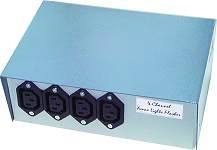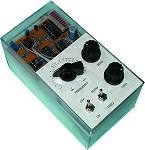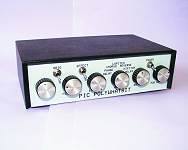


![]() PIC Polywhatsit
- we couldn't decide a name for this project - suffice it to say that
this highly versatile musical effects unit offers you all the most popular
delay-based effects in one. Echo, Reverb, Delay, Flange, Phasing, Vibrato,
Pitch multiply and more, all combined into one PIC-powered project! The
source code for the PIC microcontroller is available free from our FTP
site, so you can program your own chip, or experiment with the code if
desired.
PIC Polywhatsit
- we couldn't decide a name for this project - suffice it to say that
this highly versatile musical effects unit offers you all the most popular
delay-based effects in one. Echo, Reverb, Delay, Flange, Phasing, Vibrato,
Pitch multiply and more, all combined into one PIC-powered project! The
source code for the PIC microcontroller is available free from our FTP
site, so you can program your own chip, or experiment with the code if
desired.
![]()
![]() In the Feb.
2002 issue (P.116) a correction was published. Page 870, Fig. 2. The "ring"
of the output socket SK2 should be connected to the 0V rail and not Vref.
Wiring diagram Fig. 5 is correct.
In the Feb.
2002 issue (P.116) a correction was published. Page 870, Fig. 2. The "ring"
of the output socket SK2 should be connected to the 0V rail and not Vref.
Wiring diagram Fig. 5 is correct.

![]() Mains Failure
Alarm - an easy to build device designed for aquarium owners, also
if you have a deep freezer you'll want to build this alarm unit that warns
of power loss. Uses a small "aerial" (antenna) wire wrapped
around the mains lead to monitor power seamlessly.
Mains Failure
Alarm - an easy to build device designed for aquarium owners, also
if you have a deep freezer you'll want to build this alarm unit that warns
of power loss. Uses a small "aerial" (antenna) wire wrapped
around the mains lead to monitor power seamlessly.
![]() In the Feb.
2002 issue (P.116) a correction was published. Page 839, Fig. 2. A small
supply link wire is missing from point A17 down to B17 on the stripboard.
This is of course needed to power IC1 at pin 14.
In the Feb.
2002 issue (P.116) a correction was published. Page 839, Fig. 2. A small
supply link wire is missing from point A17 down to B17 on the stripboard.
This is of course needed to power IC1 at pin 14.
Also in this issue: New Technology Update - a brief history of l.e.d.s and how they could finally replace incandescent lamps; Ingenuity Unlimited - readers' own circuits; Interface (PC Interfacing ideas) looks at simple A/D conversion using a 12 bit chip; Net Work examines some popular shopping carts. Circuit Surgery explains the basics of different types of op.amps, concentrating on the transconductance amplifier. Marconi, the father of Radio - this being the 100th anniversary of the first transatlantic radio transmission, we celebrate the work of Guglielmo Marconi, often called the father of Radio. Our special feature looks at the man behind this momentous achievement.